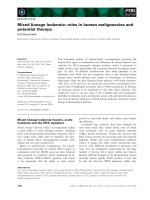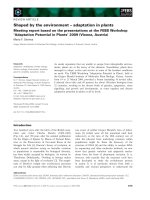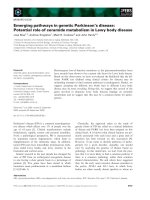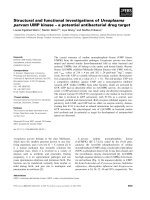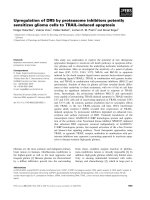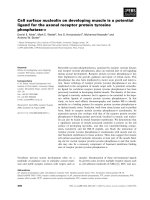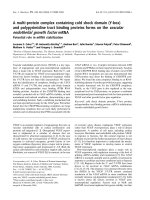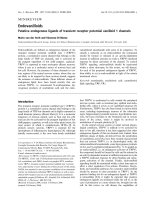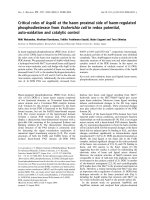Báo cáo khoa học: "" pot
Bạn đang xem bản rút gọn của tài liệu. Xem và tải ngay bản đầy đủ của tài liệu tại đây (155.04 KB, 8 trang )
OT Syntax: Decidability of Generation-based Optimization
Jonas Kuhn
Department of Linguistics
Stanford University
Abstract
In Optimality-Theoretic Syntax, optimiza-
tion with unrestricted expressive power on
the side of the OT constraints is unde-
cidable. This paper provides a proof for
the decidability of optimization based on
constraints expressed with reference to lo-
cal subtrees (which is in the spirit of OT
theory). The proof builds on Kaplan and
Wedekind’s (2000) construction showing
that LFG generation produces context-
free languages.
1 Introduction
Optimality-Theoretic (OT) grammar systems are an
interesting alternative to classical formal grammars,
as they construe the task of learning from data in
a meaning-based way: a form is defined as gram-
matical if it is optimal (most harmonic) within a set
of generation alternatives for an underlying logical
form. The harmony of a candidate analysis depends
on a language-specific ranking (
) of violable con-
straints, thus the learning task amounts to adjusting
the ranking over a given set of constraints.
(1) Candidate is moreharmonic than iff itincurs fewer
violations of the highest-ranking constraint
in
which
and differ.
The comparison-based setup of OT learning is
closely related to discriminative learning approaches
in probabilistic parsing (Johnson et al., 1999; Rie-
zler et al., 2000; Riezler et al., 2002),
1
however the
comparison of generation alternatives – rather than
parsing alternatives – adds the possibility of system-
atically learning the basic language-specific gram-
matical principles (which in probabilistic parsing
are typically fixed a priori, using either a treebank-
derived or a manually written grammar for the given
This work was supported by a postdoctoral fellowship of
the German Academic Exchange Service (DAAD).
1
This is for instance pointed out by (Johnson, 1998).
language). The “base grammar” assumed as given
can be highly unrestricted in the OT setup. Using a
linguistically motivated set of constraints, learning
proceeds with a bias for unmarked linguistic struc-
tures (cf. e.g., (Bresnan et al., 2001)).
For computational OT syntax, an interleaving of
candidate generation and constraint checking has
been proposed (Kuhn, 2000). But the decidability
of the optimization task in OT syntax, i.e., the iden-
tification of the optimal candidate(s) in a potentially
infinite candidate set, has not been proven yet.
2
2 Undecidability for unrestricted OT
Assume that the candidate set is characterized by
a context-free grammar (cfg)
, plus one addi-
tional candidate ‘yes’. There are two constraints
( ): is violated if the candidate is neither
‘yes’ nor a structure generated by a cfg ; is vi-
olated only by ‘yes’. Now, ‘yes’ is in the language
defined by this system iff there are no structures in
that are also in . But the emptiness problem
for the intersection of two context-free languages is
known to be undecidable, so the optimization task
for unrestricted OT is undecidable too.
3
However, it is not in the spirit of OT to have
extremely powerful individual constraints; the ex-
planatory power should rather arise from interaction
of simple constraints.
3 OT-LFG
Following (Bresnan, 2000; Kuhn, 2000; Kuhn,
2001), we define a restricted OT system based
on Lexical-Functional Grammar (LFG) represen-
tations: c(ategory) structure/f(unctional) structure
2
Most computational OT work so far focuses on candidates
and constraints expressible as regular languages/rational rela-
tions, based on (Frank and Satta, 1998) (e.g., (Eisner, 1997;
Karttunen, 1998; Gerdemann and van Noord, 2000)).
3
Cf. also (Johnson, 1998) for the sketch of an undecidability
argument and (Kuhn, 2001, 4.2, 6.3) for further constructions.
Computational Linguistics (ACL), Philadelphia, July 2002, pp. 48-55.
Proceedings of the 40th Annual Meeting of the Association for
pairs like (4),(5) . Each c-structure tree
node is mapped to a node in the f-structure graph
by the function . The mapping is specified by f-
annotations in the grammar rules (below category
symbols, cf. (2)) and lexicon entries (3).
4
(2) ROOT
FP VP
FP
NP FP
TOPIC
COMP* OBJ
(NP) F
SUBJ
F
F FP VP
VP (NP) V
( SUBJ)= =
V
V NP
OBJ
FP
COMP
(3) Mary NP ( PRED)=‘Mary’
(
NUM)=SG
that F
had F ( TNS)=PAST
seen V ( PRED)=‘see ( SUBJ) ( OBJ) ’
(
ASP)=PERF
thought V ( PRED)=‘think ( SUBJ) ( COMP) ’
(
TNS)=PAST
laughed V ( PRED)=‘laugh ( SUBJ) ’
(
TNS)=PAST
(4) c-structure
ROOT
VP
NP V
John V FP
thought F
F FP
that NP F
Mary F VP
had V
V NP
seen Titanic
(5) f-structure
PRED ‘think ( SUBJ) ( COMP) ’
TNS PAST
SUBJ
PRED ‘John’
NUM SG
COMP
PRED ‘see ( SUBJ) ( OBJ) ’
TNS PAST
ASP PERF
SUBJ
PRED ‘Mary’
NUM SG
OBJ
PRED ‘Titanic’
NUM SG
4
abbreviates , i.e., the present category’s image;
abbreviates , i.e., the f-structure corresponding to the
present node’s mother category.
The correct f-structure for a sentence is the min-
imal model satisfying all properly instantiated f-
annotations.
In OT-LFG, the universe of possible candidates
is defined by an LFG
(encoding inviolable
principles, like an X-bar scheme). A particular can-
didate set is the set Gen – i.e., the c-/f-
structure pairs in , which have the input
as their f-structure. Constraints are expressed as lo-
cal configurations in the c-/f-structure pairs. They
have one of the following implicational forms:
5
(6)
where are descriptions of nonterminals of ;
are standard LFG f-annotations of constraining
equations with
as the only f-structure metavariable.
(7)
where are descriptions of nonterminals
of
; refer to the mother in a local subtree
configuration,
refer to the same daughter cate-
gory;
are regular expressions over nontermi-
nals;
are standard f-annotations as in (6).
Any of the descriptions can be maximally unspe-
cific; (6) can for example be instantiated by the
OPSPEC constraint ( OP)=+ (DF ) (an operator
must be the value of a discourse function, (Bresnan,
2000)) with the category information unspecified.
An OT-LFG system is thus characterized by
a base grammar and a set of constraints, with a
language-specific ranking relation :
.
The evaluation function Eval picks the most
harmonic from a set of candidates, based on the con-
straints and ranking. The language (set of analyses)
6
generated by an OT system is defined as
Eval Gen
4 LFG generation
Our decidability proof for generation-based op-
timization builds on the result of (Kaplan and
Wedekind, 2000) (K&W00) that LFG generation
produces context-free languages.
5
Note that with GPSG-style category-level feature percola-
tion it is possible to refer to (finitely many) nonlocal configura-
tions at the local tree level.
6
The string language is obtained by taking the terminal
string of the c-structure part of the analyses.
(8) Given an arbitrary LFG grammar and a cycle-free f-
structure
, a cfg can be constructed that generates
exactly the strings to which
assigns the f-structure .
I will refer to the resulting cfg as .
K&W00 present a constructive proof, folding all f-
structural contributions of lexical entries and LFG
rules into the c-structural rewrite rules (which is
possible since we know in advance the range of f-
structural objects that can instantiate the f-structure
meta-variables in the rules). I illustrate the special-
ization steps with grammar (2) and lexicon (3) and
for generation from f-structure (5).
Initially, the generalized format of right-hand
sides in LFG rules is converted to the standard
context-free notation (resolving regular expressions
by explicit disjunction or recursive rules). F-
structure (5) contains five substructures: the root f-
structure, plus the embedded f-structures under the
paths SUBJ, COMP, COMP SUBJ, and COMP OBJ.
Any relevant metavariable (
, ) in the grammar
must end up instantiated to one of these. So for each
path from the root f-structure, a distinct variable is
introduced: , subscripted with the (abbreviated and
possibly empty) feature path: .
Rule augmentation step 1 adds to each category
name a concrete f-structure to which the category
corresponds. So for FP, we get FP: , FP: , FP: ,
FP: , and FP: . The rules are multiplied out
to cover all combinations of augmented categories
obeying the original f-annotations.
7
Step 2 adds a
set of instantiated f-annotation schemes to each sym-
bol, based on the instantiation of metavariables from
step 1. One instance of the lexicon entry Mary look
as follows:
(9) NP: :
PRED)=‘Mary’
NUM)=SG
Mary
The rules are again multiplied out to cover all
combinations for which the set of f-constraints
on the mother is the union of all daughters’ f-
constraints, plus the appropriately instantiated rule-
specific annotations. So, for the VP rule based
on the categories NP: :
PRED)=‘Mary’
NUM)=SG
and
V : :
PRED)=‘laugh’
TNS)=PAST
, we get the rule
7
VP:
NP: V : is allowed, while
VP:
NP: V : is excluded, since the = annotation
of V
in the VP rule (2) enforces that VP V .
VP: :
SUBJ
PRED)=‘Mary’
NUM)=SG
PRED)=‘laugh’
TNS)=PAST
NP: :
PRED)=‘Mary’
NUM)=SG
V : :
PRED)=‘laugh’
TNS)=PAST
With this bottom-up construction it is ensured that
each new category ROOT: : (corresponding to
the original root symbol) contains a complete pos-
sible collection of instantiated f-constraints. To ex-
clude analyses whose f-structure is not (for which
we are generating strings) a new start symbol is in-
troduced “above” the original root symbol. Only for
the sets of f-constraints that have as their minimal
model, rules of the form ROOT ROOT: : .
are introduced (this also excludes inconsistent f-
constraint sets).
With the cfg , standard techniques for
cfg’s can be applied, e.g., if there are infinitely many
possible analyses for a given f-structure, the small-
est one(s) can be produced, based on the pumping
lemma for context-free languages. Grammar (2)
does indeed produce infinitely many analyses for the
input f-structure (5). It overgenerates in several re-
spects: The functional projection FP can be stacked
due to recursions like the following (with the aug-
mented FP reoccuring in the F
rules):
FP: :
PRED)=‘see . ’
TNS)=PAST
SUBJ
PRED)=‘Mary’
OBJ
PRED)=‘Titanic’
F : :
PRED)=‘see . ’
TNS)=PAST
SUBJ
PRED)=‘Mary’
OBJ
PRED)=‘Titanic’
F : :
PRED)=‘see . ’
TNS)=PAST
SUBJ
PRED)=‘Mary’
OBJ
PRED)=‘Titanic’
F: : FP: :
PRED)=‘see . ’
TNS)=PAST
SUBJ
PRED)=‘Mary’
OBJ
PRED)=‘Titanic’
F: : is one of the augmented categories we get
for that in (3), so ((2),(5)) generates an arbitrary
number of thats on top of any FP. A similar repeti-
tion effect will arise for the auxiliary had.
8
Other
choices in generation arise from the freedom of gen-
erating the subject in the specifier of VP or FP and
from the possibility of (unbounded) topicalization of
the object (the first disjunction of the FP rule in (2)
8
The F
entries do not contribute any PRED value, which
would exclude doubling due to the instantiated symbol charac-
ter of PRED values (cf. K&W00, fn. 2).
contains a functional-uncertainty equation):
(10) a. John thought that Titanic, Mary had seen.
b. Titanic, John thought that Mary had seen.
5 LFG generation in OT-LFG
While grammar (2) would be considered defective
as a classical LFG grammar, it constitutes a rea-
sonable example of a candidate generation grammar
( ) in OT. Here, it is the OT constraints that
enforce language-specific restrictions, so has
to ensure that all candidates are generated in the
first place. For instance, expletive elements as do in
Who do you know will arise by passing a recursion
in the cfg constructed during generation. A candi-
date containing such a vacuous cycle can still be-
come the winner of the OT competition if the Faith-
fulness constraint punishing expletives is outranked
by some constraint favoring an aspect of the recur-
sive structure. So the harmony is increased by going
through the recursion a certain number of times. It
is for this very reason, that Who do you know is pre-
dicted to be grammatical in English.
So, in OT-LFG it is not sufficient to apply just
the
construction; I use an additional step: prior
to application of , the LFG grammar is
converted to a different form (depend-
ing on the constraint set ), which is still an LFG
grammar but has category symbols which reflect lo-
cal constraint violations. When the construc-
tion is applied to , all “pumping” struc-
tures generated by the cfg
can indeed be ignored since all OT-relevant candi-
dates are already contained in the finite set of non-
recursive structures. So, finally the ranking of the
constraints is taken into consideration in order to de-
termine the harmony of the candidates in this finite
subset.
6 The conversion
Preprocessing Like K&W00, I assume an initial
conversion of the c-structure part of rules into stan-
dard context-free form, i.e., the right-hand side is a
category string rather than a regular expression. This
ensures that for a given local subtree, each constraint
(of form (6) or (7)) can be applied only a finite num-
ber of times: if is the arity of the longest right-hand
side of a rule, the maximal number of local viola-
tions is (since some constraints of type (7) can be
instantiated to all daughters).
Grammar conversion With the number of local vi-
olations bounded, we can encode all candidate dis-
tinctions with respect to constraint violations at the
local-subtree level with finite means: The set of
categories in the newly constructed LFG grammar
is the finite set
(11) : the set of categories in
:
a nonterminal symbol of ,
the size of the constraint set ,
,
the arity of the longest rhs in rules of
The rules in are constructed in such a
way that for each rule
X
X X
in and each sequence ,
, all rules of the form
X : X : X : ,
are included such that (the number of violations
of constraint incurred local to the rule) and the
f-annotations are specified as follows:
(12) for of form (6) :
a. ; ( )
if X
does not match the condition ;
b. ; ; ( )
if X
matches ;
c. ; ; ( )
if X matches both and ;
d. ; ; ( )
if X matches but not ;
e. ; ; ( )
if X matches both and ;
(13) for of form (7) :
a. ; ( )
if X
does not match the condition ;
b. ; ( ),
where
i. ;
if X does not match , or X X do not match ,
or X
X do not match ;
ii. ;
if X matches both and ; X matches both and
; X . X match and ; X X match
and ;
iii. ;
if X matches both and ; X matches both and
; X . X match and ; X X match
and ;
iv. ;
if X matches , X matches , X X match ,
X
X match , but (at least) one of them does
not match the respective description in the consequent
(
);
v. ;
if X matches both and ; X matches both and
; X . X match and ; X X match
and .
Note that the constraint profile of the daughter
categories does not play any role in the determi-
nation of constraint violations local to the subtree
under consideration (only the sequences are re-
stricted by the conditions (12) and (13)). So for each
new rule type, all combinations of constraint profiles
on the daughters are constructed (creating a large but
finite number of rules).
9
This ensures that no sen-
tence that can be parsed (or generated) by is
excluded from (as stated by fact (14)):
10
(14) Coverage preseveration
All strings generated by an LFG grammar
are also gen-
erated by
.
The original analysis can be recovered from an
analysis by applying a projection function
Cat to all c-structure categories:
Cat :
for every category in (11)
9
For one rule/constraint combination several new rules can
result; e.g., if the right-hand side of a rule (X ) matches both the
antecedent (
) and the consequent ( ) category description
of a constraint of form (6), three clauses apply: (12b), (12c),
and (12d). So, we get two new rules with the count of 0 local
violations of the constraint and two rules with count 1, with a
difference in the f-annotations.
10
Providing all possible combinations of augmented category
symbols on the right-hand rule sides in ensures that the
newly constructed rules can be reached from the root symbol in
a derivation. It is also guaranteed that whenever a rule
in
contributes to an analysis, at least one of the rules constructed
from
will contribute to the corresponding analysis in .
This is ensured since the subclauses in (12) and (13) cover the
full space of logical possibilities.
We can overload the function name Cat with a func-
tion applying to the set of analyses produced by an
LFG grammar by defining
Cat , is derived from by
applying Cat to all category symbols .
Coverage preservation of the construction holds
also for the projected c-category skeleton (cf. the ar-
gumentation in fn. 10):
(15) C-structure level coverage preservation
For an LFG grammar
: Cat
Each category in encodes the number of
local violations for all constraints. Since all con-
straints are locally evaluable by assumption, all con-
straints violated by a candidate analysis have to be
incurred local to some subtree. Hence the total
number of constraint violations incurred by a can-
didate can be computed by simply summing over all
category-encoded local violation profiles:
(16) Total number of constraint violations
Let Nodes
be the multiset of categories occurring in
the c-structure tree
, then the total number of viola-
tions of constraint
incurred by an analysis
is
Define
Total
7 Applying on
Since is a standard LFG grammar, we
can apply the construction to it to get a cfg
for a given f-structure . The category symbols
then have the form X: : : , with and
arising from the construction. We can over-
load the projection function Cat again such that
Cat : : : for all augmented category sym-
bol of the new format; likewise Cat for a cfg.
Since the construction (strongly) preserves
the language generated, coverage preservation holds
also after the application of to and
, respectively:
(17) Cat
Cat
But since the symbols in reflect local
constraint violations, Cat
has the property that all instances of recursion in the
resulting cfg create candidates that are at most as
harmonic as their non-recursive counterparts. As-
suming a projection function CatCount : : :
: , we can state more formally:
(18) If and are CatCount projections of trees produced
by the cfg
, using exactly the
same rules, and
contains a superset of the nodes that
contains, then
, for all
from Total ,
and Total .
This fact follows from definition of Total (16): the
violation counts in the additional nodes in will
add to the total of constraint violations (and if none
of the additional nodes contains any local constraint
violation at all, the total will be the same as in
).
Intuitively, the effect of the augmentation of the cat-
egory format is that certain recursions in the pure
construction (which one may think of as a
loop) are unfolded, leading to a longer loop. The
new loop is sufficiently large to make all relevant
distinctions.
This result can be directly exploited in processing:
if all non-recursive analyses are generated (of which
there are only finitely many) it is guaranteed that a
subset of the optimal candidates is among them. If
the grammar does not contain any violation-free re-
cursion, we even know that we have generated all
optimal candidates.
(19) A recursion with the derivation path
is
called violation-free iff all categories dominated by the
upper occurrence of , but not dominated by the lower
occurrence of
have the form with
Note that if there is an applicable violation-free re-
cursion, the set of optimal candidates is infinite; so
if the constraint set is set up properly in a linguis-
tic analysis, one would assume that violation-free
recursion should not arise. (Kuhn, 2000) excludes
the application of such recursions by a similar con-
dition as offline parsability (which excludes vacu-
ous recursions over a string in parsing), but with the
construction, this condition is not necessary
for decidability of the generation-based optimization
task. The cfg produced by can be transformed
further to only generate the optimal candidates ac-
cording to the constraint ranking of the OT sys-
tem , eliminating all but the
violation-free recursions in the grammar:
(20) Creating a cfg that produces all optimal candidates
a. Define
contains no
recursion
.
is finite and can be easily computed, by keeping
track of the rules already used in an analysis.
b. Redefine Eval
to apply on a set of context-free
analyses with augmented category symbols with counts
of local constraint violations:
Eval
is maximally harmonic
in
, under ranking
Using the function Total defined in (16), this function is
straightforward to compute for finite sets, i.e., in particu-
lar Eval
.
c. Augment the category format further by one index
component.
11
Introduce index
for all categories in
of the form X: : : ,
where for . Introduce a new unique in-
dex
for each node of the form X: : : ,
where for some occurring in the
analyses Eval
(i.e., different occurrences of
the same category are distinguished).
d. Construct the cfg
S ,
where are the indexed symbols of step c.;
S is a new start symbol; the rules are (i) those
rules from
which were used in
the analyses in Eval – with the original
symbols replaced by the indexed symbols –, (ii) the
rules in , in which the mother
category and all daughter categories are of the form
X: : : , for (with the new
index added), and (iii) one rule S S : for each
of the indexed versions S
: of the start symbols of
.
With the index introduced in step (20c), the origi-
nal recursion in the cfg is eliminated in all but the
violation-free cases. The grammar Cat pro-
duces (the c-structure of) the set of optimal candi-
dates for the input :
12
(21) Cat
Eval Gen ,
i.e., the set of c-structures for the optimal candidates for
input f-structure according to the OT system
.
11
The projection function Cat is again overloaded to also re-
move the index on the categories.
12
Like K&W00, I make the assumption that the input f-
structure in generation is fully specified (i.e., all the candidates
have the form
), but the result can be extended to allow
for the addition of a finite amount of f-structure information in
generation. Then, the specified routine is computed separately
for each possible f-structural extension and the results are com-
pared in the end.
8 Proof
To prove fact (21) we will show that the c-structure
of an arbitrary candidate analysis generated from
with is contained in Cat iff all
other candidates are equally or less harmonic.
Take an arbitrary candidate c-structure gen-
erated from with such that
Cat . We have to show that all other candi-
dates generated from are equally or less har-
monic than . Assume there were a that is more
harmonic than . Then there must be some con-
straint , such that violates fewer times
than does, and is ranked higher than any other
constraint in which and differ. Constraints have
to be incurred within some local subtree; so must
contain a local violation configuration that
does
not contain, and by the construction (12)/(13) the
-augmented analysis of – call it – must
make use of some violation-marked rule not used in
. Now there are three possibilities:
(i) Both and are free of recursion.
Then the fact that avoids the highest-ranking
constraint violation excludes from Cat (by
construction step (20b)). This gives us a contradic-
tion with our assumption.
(ii) contains a recursion and is free
of recursion. If the recursion in is violation-
free, then there is an equally harmonic recursion-
free candidate . But this is also less har-
monic than , such that it would have been ex-
cluded from Cat too. This again means that
would also be excluded (for lack of the rel-
evant rules in the non-recursive part). On the other
hand, if it were the recursion in that incurred
the additional violation (as compared to ),
then there would be a more harmonic recursion-free
candidate . However, this would exclude
the presence of in by construction step
(20c,d) (only violation-free recursion is possible).
So we get another contradiction to the assumption
that Cat .
(iii) contains a recursion. If this recursion
is violation-free, we can pick the equally harmonic
candidate avoiding the recursion to be our ,
and we are back to case (i) and (ii). Likewise, if the
recursion in
does incur some violation, not
using the recursion leads to an even more harmonic
candidate, for which again cases (i) and (ii) will ap-
ply.
All possible cases lead to a contradiction with the
assumptions, so no candidate is more harmonic than
our
Cat .
We still have to prove that if the c-structure of a
candidate analysis generated from with
is equally or more harmonic than all other candi-
dates, then it is contained in Cat . We can
construct an augmented version of , such that
Cat and then show that there is a homo-
morphism mapping to some analysis
with Cat .
We can use the constraint marking construction
and the construction to construct the tree
with augmented category symbols of the analysis
. The result of K&W00 plus (17) guarantee that
Cat . Now, there has to be a homo-
morphism from the categories in to the cate-
gories of some analysis in . is also based
on (with an additional index
on each category and some categories and rules of
having no counterpart in ).
Since we know that is equally or more harmonic
than any other candidate generated from , we
know that the augmented tree either contains no
recursion or only violation-free recursion. If it does
contain such violation-free recursions we map all
categories on the recursion paths to the indexed
form : , and furthermore consider the variant of
avoiding the recursion(s). For our (non-recursive)
tree, there is guaranteed to be a counterpart in the
finite set of non-recursive trees in with all cat-
egories pairwise identical apart from the index in
. We pick this tree and map each of the cate-
gories in to the -indexed counterpart. The exis-
tence of this homomorphism guarantees that an anal-
ysis exists with Cat Cat
. QED
9 Conclusion
We showed that for OT-LFG systems in which all
constraints can be expressed relative to a local sub-
tree in c-structure, the generation task from (non-
cyclic
13
) f-structures is solvable. The infinity of
13
The non-cyclicity condition is inherited from K&W00; in
linguistically motivated applications of the LFGformalism, cru-
the conceptually underlying candidate set does not
preclude a computational approach. It is obvious
that the construction proposed here has the purpose
of bringing out the principled computability, rather
than suggesting a particular algorithm for imple-
mentation. However on this basis, an implementa-
tion can be easily devised.
The locality condition on constraint-checking
seems unproblematic for linguistically relevant con-
straints, since a GPSG-style slash mechanism per-
mits reference to (finitely many) nonlocal configu-
rations from any given category (cf. fn. 5).
14
Decidability of generation-based optimization
(from a given input f-structure) alone does not im-
ply that the recognition and parsing tasks for an OT
grammar system defined as in sec. 3 are decidable:
for these tasks, a string is given and it has to be
shown that the string is optimal for some underlying
input f-structure (cf. (Johnson, 1998)). However, a
similar construction as the one presented here can
be devised for parsing-based optimization (even for
an LFG-style grammar that does not obey the offline
parsability condition). So, if the language generated
by an OT system is defined based on (strong) bidi-
rectional optimality (Kuhn, 2001, ch. 5), decidabil-
ity of both the general parsing and generation prob-
lem follows.
15
For the unidirectionally defined OT
language (as in sec. 3), decidability of parsing can
be guaranteed under the assumption of a contextual
recoverability condition in parsing (Kuhn, in prepa-
ration).
References
Joan Bresnan, Shipra Dingare,and Christopher Manning.
2001. Soft constraints mirror hard constraints: Voice
and person in English and Lummi. In Proceedings of
the LFG 2001 Conference. CSLI Publications.
cial use of cyclicity in underlying semantic feature graphs has
never been made.
14
A hypothetical constraint that is excluded would be a paral-
lelism constraint comparing two subtree structures of arbitrary
depth. Such a constraint seems unnatural in a model of gram-
maticality. Parallelism of conjuncts does play a role in models
of human parsing preferences; however, here it seems reason-
able to assume an upper bound on the depth of parallel struc-
tures to be compared (due to memory restrictions).
15
Parsing: for a given string, parsing-based optimization
is used to determine the optimal underlying f-structure; then
generation-based optimization is used to check whether the
original string comes out optimal in this direction too. Gen-
eration is symmetrical, starting with an f-structure.
Joan Bresnan. 2000. Optimal syntax. In Joost Dekkers,
Frank van der Leeuw, and Jeroen van de Weijer, edi-
tors, Optimality Theory: Phonology, Syntax, and Ac-
quisition. Oxford University Press.
Jason Eisner. 1997. Efficient generation in primitive
optimality theory. In Proceedings of the ACL 1997,
Madrid.
Robert Frank andGiorgio Satta. 1998. Optimality theory
and the generative complexity of constraint violation.
Computational Linguistics, 24(2):307–316.
Dale Gerdemann and Gertjan van Noord. 2000. Approx-
imation and exactness in finite state Optimality The-
ory. In SIGPHON 2000, Finite State Phonology. 5th
Workshop of the ACL Special Interest Group in Comp.
Phonology, Luxembourg.
Mark Johnson, Stuart Geman, Stephen Canon, Zhiyi Chi,
and Stefan Riezler. 1999. Estimators for stochastic
“unification-based” grammars. In Proceedings of the
37th Annual Meeting of the Association for Computa-
tional Linguistics (ACL’99), College Park, MD, pages
535–541.
Mark Johnson. 1998. Optimality-theoretic Lexical Func-
tional Grammar. In Proceedings of the 11th Annual
CUNY Conference on Human Sentence Processing,
Rutgers University.
Ronald M. Kaplan and J¨urgen Wedekind. 2000.
LFG generation produces context-free languages.
In Proceedings of COLING-2000, pages 297–302,
Saarbr¨ucken.
Lauri Karttunen. 1998. The proper treatment of optimal-
ity in computational phonology. In Proceedings of the
Internat. Workshop on Finite-StateMethods in Natural
Language Processing, FSMNLP’98, pages 1–12.
Jonas Kuhn. 2000. Processing Optimality-theoretic syn-
tax by interleaved chart parsing and generation. In
Proceedings of ACL 2000, pages 360–367, Hongkong.
Jonas Kuhn. 2001. Formal and Computational As-
pects of Optimality-theoretic Syntax. Ph.D. thesis, In-
stitut f¨ur maschinelle Sprachverarbeitung, Universit¨at
Stuttgart.
Jonas Kuhn. in preparation. Decidability of generation
and parsing for OT syntax. Ms., Stanford University.
Stefan Riezler, Detlef Prescher, Jonas Kuhn, and Mark
Johnson. 2000. Lexicalized stochastic modeling of
constraint-based grammars using log-linear measures
and EM training. In Proceedings of the 38th Annual
Meeting of the Associationfor Computational Linguis-
tics (ACL’00), Hong Kong, pages 480–487.
Stefan Riezler, Dick Crouch, Ron Kaplan, Tracy King,
John Maxwell, and Mark Johnson. 2002. Parsing the
Wall Street Journal using a Lexical-Functional Gram-
mar and discriminative estimation techniques. This
conference.
